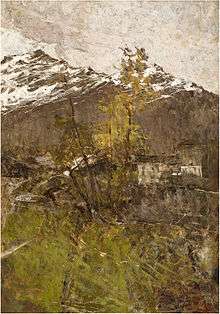Francesco Filippini
Francesco Filippini (18 September 1853 – 6 March 1895) was an Italian painter from Lombardy. He was much influenced by Tranquillo Cremona.[1]
Francesco Filippini | |
|---|---|
.jpg) Francesco Filippini, self-portrait | |
| Born | 18 September 1853 Brescia, Italy |
| Died | 6 March 1895 Milan, Italy |
| Nationality | Italian |
| Education |
|
| Known for | landscapes, seascapes |
| Movement | Scapigliatura |
| Awards |
|

Life
Filippini was born in Brescia, in Lombardy in northern Italy, on 18 September 1853, into a poor family. His father Lorenzo was a carpenter, his mother Silvia Signoria a seamstress. He was soon sent to work, first as a waiter in a pastry-shop, later as a clerk to a notary public.[1]
Filippini attended the school of drawing at the Pinacoteca Tosio; from 1872 he received a grant from the city council to continue these studies.[1] In 1875 he received an allowance to study under Giuseppe Bertini in Milan.[2]:79 In 1879 another grant allowed him to travel to Paris to visit the Salon.[1]
Filippini exhibited at the annual shows of the Accademia di Belle Arti di Brera in Milan from 1879, and from 1880 lived in that city. He made his living by teaching, both in schools and privately. He was made an honorary member of the Accademia di Brera in 1878.[1]
He died in Milan on 6 March 1895.[1]
Work
When young, Filippini painted mostly religious or historical subjects,[3] as well as some portraits. In later life he painted mostly landscapes – of the Apennines, of Pegli, of Porto Valtravaglia, of the Val Camonica or of the Valle Seriana – or seascapes in Chioggia, Genova, Naples or Venice. His work shows the influence of the Scapigliatura painter Tranquillo Cremona.[1]
References
- Valerio Terraroli (1997). Filippini, Francesco (in Italian). Dizionario Biografico degli Italiani, volume 47. Roma: Istituto dell’Enciclopedia Italiana. Accessed September 2015.
- Vespasiano Bignami (ed.) (1900). La pittura lombarda nel secolo XIX (exhibition catalogue, in Italian). Milan: Tipografia Capriolo e Massimino for the Società per le Belle Arti.
- Filippini, Francesco. Benezit Dictionary of Artists. Oxford Art Online. Oxford: Oxford University Press. Accessed May 2016. (subscription required)
Further reading
- Vasco Frati (1999). Francesco Filippini: 1853-1895: un protagonista del naturalismo lombardo (exhibition catalogue, in Italian). Milan:Skira. ISBN 9788881186716.
![]()
![]()
| Wikiquote has quotations related to: Francesco Filippini |